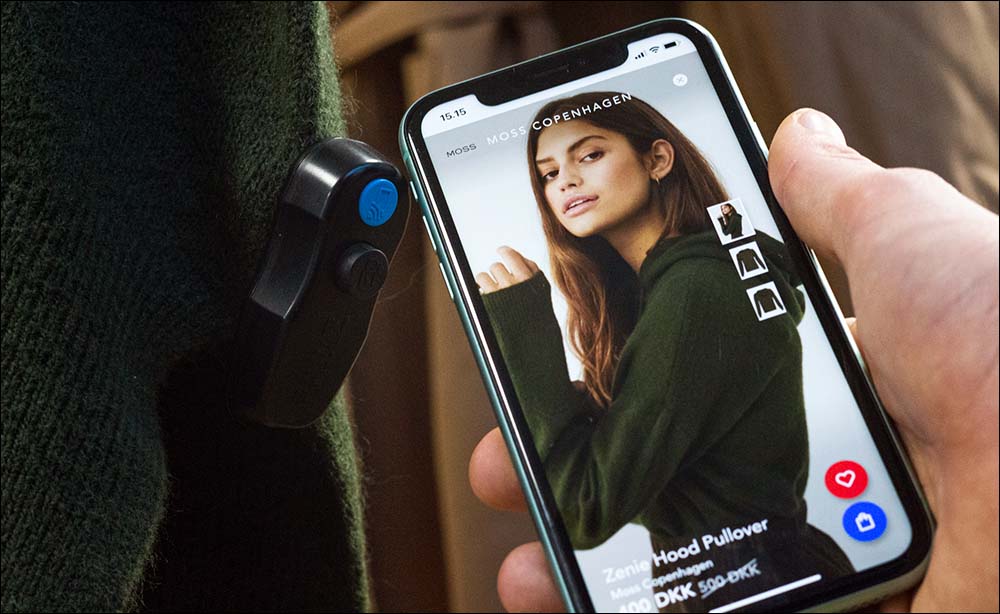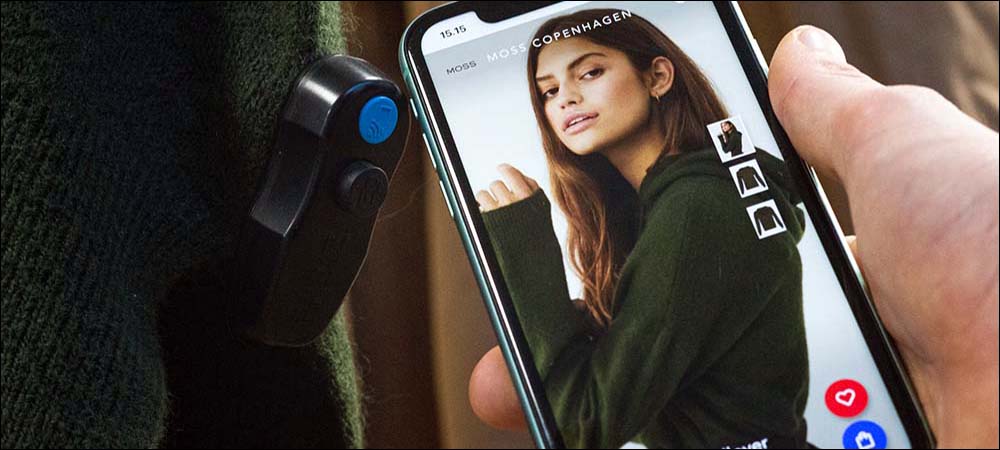Danish technology startup Zliide has created a Bluetooth Low Energy (BLE) security tag and app that has been adopted by 10 small fashion stores throughout Denmark, with plans for pilots with several major European apparel chains and retailers in the United States in early 2021. Zliide’s hard tag connects with shoppers’ smartphones, enabling them to view information about a particular product and make a purchase, then unlocking the tag to complete the self-checkout process. Once the tag is removed, customers can walk out of a store with their purchased items, and the app will provide them with updated inventory data regarding what is still for sale.
If users opt to purchase another item at the store after leaving, Zliide will complete the purchase for them. The company’s personnel will then, in some cases, deliver the product to the shopper locally within three hours. To date, says Morten Mogelmose, Zliide’s cofounder and CEO, stores providing the solution to their customers report an adoption rate of 41 percent. That means nearly half of all shoppers who make a purchase are doing so with the app. Others are still seeking help from sales associates and using a physical point-of-sale system.

The hard tag is designed to be smaller than standard hard tags, the company reports, and it leverages Silicon Labs‘ BGM220 system-in-package module for Bluetooth connectivity, which measures 6 millimeters by 6 millimeters (0.24 inch by 0.24 inch). The tag measures 53 millimeters by 19 millimeters by 25 millimeters (2.1 inches by 0.75 inch by 1 inch). Mogelmose says Zliide designed the BLE system as a way to make brick-and-mortar store shopping more convenient.
Mogelmose first conceived of the product after visiting a prominent and busy apparel retailer in London. “I was amazed by the store and the product,” he says, “but the checkout experience was terrible.” It required customers to wait in long queues to be served, making the in-store shopping experience time-consuming and frustrating. “I thought there must be a better way than this.” He cites convenience-centered products and trends that have revolutionized other sectors, such as Uber for transportation and Airbnb for hospitality.
The retail industry, on the other hand, has not provided significant consumer convenience solutions, Mogelmose says, since the introduction of card-payment systems in the 1980s. Therefore, Zliide offers a Bluetooth-enabled hard tag intended to bring convenience to those shopping at stores, delivering automation and self-service to consumers in order to spare them from waiting in queues for manual assistance. The tag’s Bluetooth SIP is built into a hard, plastic case that can be attached to a garment and be locked similarly to with standard hard tags.
Each tag is encoded with a unique ID number that is linked in the Zliide app to data about the specific product. Typically, when new garments are received at the store, workers use the Zliide app to scan the barcode on each product label and read the Bluetooth-based ID number on the hard tag being attached to that garment. The tag’s unique ID is linked to the barcode data in the app, Mogelmose explains, which stores that information to indicate that that garment is at the store and available for purchase.
Upon entering the store, a shopper downloads the app on his or her iOS- or Android-based smartphone. If the visitor finds a product of interest, she or he can place the phone within a few centimeters of the tag. The phone’s built-in Bluetooth radio will interrogate the tag and forward its ID number to the app. The phone can then open information about that product, including images of the garment being worn by models, as well as sizing and pricing data. If the shopper wishes to purchase that item, he or she can select the purchase option, provide payment information and approve the transaction.

Morten Mogelmose
That process will initiate an unlocking prompt that is sent by the phone back to the hard tag. The tag releases its lock and the shopper can simply remove it from the garment and place it in a dedicated bin. In the meantime, the app updates the inventory data to indicate that the product has been purchased, and the shopper can leave the store with that item. The app is updated with the latest inventory data from the store, which means the consumer can virtually shop at the store again using the same smartphone after leaving. For instance, if the customer had been interested in a product while at the store, she or he could browse for it again in the app and make a purchase by simply pressing the prompt. Zliide also provides delivery service in some cases.
The solution is intended to offer value not only to shoppers but also store management. Managers can view data on what is referred to as the application’s “brain,” including overall store activity and information about single products, such as every time a given tag is tapped or a product is purchased. They can view shopper behaviors and statistics regarding each customer, such as his or her gender and age. This, Mogelmose says, provides the kind of data that online platforms like Amazon already manage in order to understand customers’ shopping behaviors.
“We provide the retailer with all the dashboards,” Mogelmose explains, so that they can see activity in one or all of their stores, based on purchasing data. With this information, managers can better understand products of interest at specific locations, as well as shopper demographics. The inventory data is based on each interaction with a shopper’s or store associate’s mobile phone. If management wanted to view which products were being removed from the store, an electronic article surveillance (EAS) or RFID system could be added to the solution with a reader installed at the doorway.
When the hard tag was being designed, Mogelmose says, consideration was paid to the best technology for the application. Although the system would work with NFC, he notes, BLE was chosen since it offers a more ubiquitous technology for all consumer smartphones’ operating systems. Early models of iOS-based devices do not provide NFC access to developers. Silicon Labs worked with Zliide to provide the best functionality for the application, according to Chong Li, Silicon Labs’ senior product marketing manager.
The chip manufacturer recently released an SiP version of its Bluetooth Low Energy Series 2 chip. An SiP, as opposed to a system-on-a-chip (SoC), offers a relatively smaller footprint, Li explains, since all external components required to operate the chip are built into a single package. It also enables a faster time to market, he adds, since the SiP module provides Bluetooth and regulatory certifications for Europe (CE), the United States (FCC), Canada (ICED), Japan (MIC) and South Korea (KC).

Chong Li
The SiP module was first released in September 2020, Li says, and the Silicon Labs product is being used in retail for electronic shelf labels, payment tags and loss-prevention tags, as well as for a variety of medical devices with Bluetooth connectivity between medical devices and smartphones. Because the SIP includes all necessary passive components into a single package, he reports, its overall footprint is smaller than an SoC version, making it an appropriate fit for the Zliide hard tag. The chip Zliide is leveraging also includes configurable output power so that the application can be configured for a short read range versus long-range connections.
With regard to Zliide’s solution, the system requires a short read to ensure that there are no stray transmissions from other tags within the area, or to other shopper phones running the app. Silicon Labs’ chip offers a security feature to ensure the safety of data transmitted wirelessly. “Security is going to be especially relevant in any location where exposure to potential hackers or physical attacks exists,” Li says. The Silicon Labs chip portfolio comes with PSA Level 2 precertification, a scheme of requirements for Internet of Things hardware and software.
In addition, Silicon Labs has been working with Zliide to create a new version of the system that would enable Bluetooth for item finding, known as Bluetooth AoA (angle of arrival), which would include the installation of an antenna infrastructure around a facility. The fixed antennas would receive beacon data from the hard tags, then use triangulation algorithms to detect where items were located. The location-based data could be used for other applications as well, Li says, including at manufacturing sites and for logistics, such as in distribution centers.
Zliide started developing its solution three years ago, then took the technology live with retailer customers in January 2020. The company expects to either pilot or launch the system at more than 50 additional stores this year. “We want to provide those retailers with technology that can enable a modern experience,” Mogelmose says, “as well as reach the consumer more directly.” By collecting inventory data regarding what is in the store, the system is designed to share that information with shoppers and store management.
That kind of inventory visibility for consumers has rarely been offered, Mogelmose claims, despite the increased use of technology to capture stock-count data, such as with UHF RFID tags. “I love inventory counts and everything RFID can do,” he states, “but when we talk about omnichannel, I think too often we have been forgetting the customer. Inventory visibility should be just as much for the customer as it is for the back office.”
The solution is provided via monthly subscription, in which case users can lease the tags or buy them outright. Silicon Labs finds the Zliide application particularly interesting and disruptive, Li says, adding, “This is one of the few examples we’ve seen where technology can really address consumer behavior.” The use case is of value to both the retailer and the consumer, he reports. “I think they have nailed it when it comes to bringing the online experience into the physical store. It’s quite exciting.”


